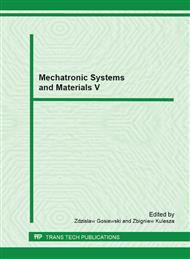[1]
M.F. Abbod, J.W.F. Catto, D.A. Linkens, P.J. Wild, A. Herr, C. Wissmann, C. Pilarsky, A. Hartmann, F.C. Hamdy, Artificial Intelligence Technique for Gene Expression Profiling of Urinary Bladder Cancer, In: 3rd Inter. IEEE Conference Intelligent Systems. (2006).
DOI: 10.1109/is.2006.348495
Google Scholar
[2]
J.W.F. Catto, D.A. Linkens, M.F. Abbod, M. Chen, J.L. Burton, K.M. Feeley, F.C. Hamdy, Artificial Intelligence in Predicting Bladder Cancer Outcome, A Comparison of Neuro-Fuzzy Modeling and Artificial Neural Networks, Clinical Cancer Research. 9 (2003).
DOI: 10.1016/s1569-9056(03)80262-2
Google Scholar
[3]
R.N.G. Naguib, K.N. Qureshi, F.C. Hamdy, D.E. Neal, Neural Network analysis of Prognostic Markers in Bladder Cancer, In: 19th International Conference IEEE/EMBS. 3 (1997) 646-651.
DOI: 10.1109/iembs.1997.756515
Google Scholar
[4]
E.J. Tkacz, P. Kostka, K. Jonderko, B. Mika, Supervised and Unsupervised Learning Systems as a Part of Hybrid Structures Applied in EGG Signals Classifiers, IEEE Annual Conference Engineering in Medicine and Biology. (2005).
DOI: 10.1109/iembs.2005.1617042
Google Scholar
[5]
J.T. Wei, A. Tewari, Artificial Neural Networks in Urology, Pro. Urology. 54 (1999) 945–948.
DOI: 10.1016/s0090-4295(99)00341-6
Google Scholar
[6]
T. Habuchi, M. Marberger, M.J. Droller, et al., Prognostic markers for bladder cancer, International Consensus Panel on Bladder Tumor Markers. Urology. 66 (2005) 64-74.
DOI: 10.1016/j.urology.2005.08.065
Google Scholar
[7]
A. Tewari, P. Narayan, Novel staging tool for localized prostate cancer: a pilot study using genetic adaptive neural networks, J Urol. 160 (1998) 430–438.
DOI: 10.1016/s0022-5347(01)62916-1
Google Scholar
[8]
P.B. Snow, D.M. Rodvold, J.M. Brandt, Artificial Neural Networks in Clinical Urology, Urology. 54 (1999) 787-790.
DOI: 10.1016/s0090-4295(99)00327-1
Google Scholar
[9]
P.B. Snow, D.S. Smith, W.J. Catalona, Artificial neural networks in the diagnosis and prognosis of prostate cancer: a pilot study, J Urol. 152 (1994) 1923-(1926).
DOI: 10.1016/s0022-5347(17)32416-3
Google Scholar
[10]
E.K. Michaels, C.S. Niederberger, R.M. Golden, et al., Use of a Neural Network to Predict Stone Growth After Shock Wave Lithotripsy, Urology. 51 (1998) 335–338.
DOI: 10.1016/s0090-4295(97)00611-0
Google Scholar
[11]
S.F. Shariat, P.I. Karakiewicz, G.S. Palapattu, G.E. Amiel, Y. Lotan, C.G. Rogers, A. Vazina, et al., Nomograms Provide Improved Accuracy for Predicting Survival after Radical Cystectomy, Clin Cancer Res. 12, 22 (2006) 6663-76.
DOI: 10.1158/1078-0432.ccr-06-0372
Google Scholar
[12]
A.J. Colquhoun, G.D. Jones, M.A. Moneef, et al., Improving and predicting radiosensitivity in muscle invasive bladder cancer, J Urol. 169 (2003) 1983–(1992).
DOI: 10.1097/01.ju.0000067941.12011.40
Google Scholar
[13]
A. Lopez-Beltran, G. Sauter, T. Gasser, et al., Infiltrating urothelial carcinoma, In: Eble JN, et al, editors, WHO classification of tumours, Pathology and genetics, Tumours of the urinary system and male genital organs. Lyon, France7 IARC Press. (2004).
Google Scholar
[14]
W. Jóźwicki , P. Jarzemski , M. Kolasa , R. Golda , J. Domaniewski, Nonclassic differentiation number (NDN)-important additional information about urothelial cancer, European Urology Supplements. 7, 3 (2008) 560.
DOI: 10.1016/s1569-9056(08)60556-4
Google Scholar
[15]
T. Kohonen, Self-Organizing Maps, third edition, Springer Berlin, (2001).
Google Scholar
[16]
T. Mokriš, R. Forgáč, Decreasing the Feature Space Dimension by Kohonen Self-Orgaizing Maps, 2nd Slovakian – Hungarian Joint Symposium on Applied Machine Intelligence. (2004).
Google Scholar
[17]
E. Uriarte and F. Martin, Topology preservation in SOM, Int. J. Appl. Math. Comput. Sci. 1, 1 (2005) 19–22.
Google Scholar
[18]
D. Beaton, I. Valova, and D. MacLean, CQoCO: A measure for comparative quality of coverage and organization for self-organizing maps, Neurocomputing. 73, 10–12 (2010) 2147–2159.
DOI: 10.1016/j.neucom.2010.02.004
Google Scholar
[19]
T. Faisal, M. N. Taib, F. Ibrahim, Reexamination of risk criteria in dengue patients using the self-organizing map, Medical & Biological Engineering & Computing. 48, 3 (2010) 293-301.
DOI: 10.1007/s11517-009-0561-x
Google Scholar
[20]
J. Vesanto, E. Alhoniemi, Clustering of the self-organizing map, IEEE Transactions on Neural Networks. 11, 3 (2000) 586-600.
DOI: 10.1109/72.846731
Google Scholar
[21]
M. Kolasa, R. Długosz, W. Pedrycz, M. Szulc, Programmable Triangular Neighborhood Function for Kohonen Self-Organizing Map Implemented on Chip, Neural Networks, Elsevier. 25 (2012) 146–160.
DOI: 10.1016/j.neunet.2011.09.002
Google Scholar


